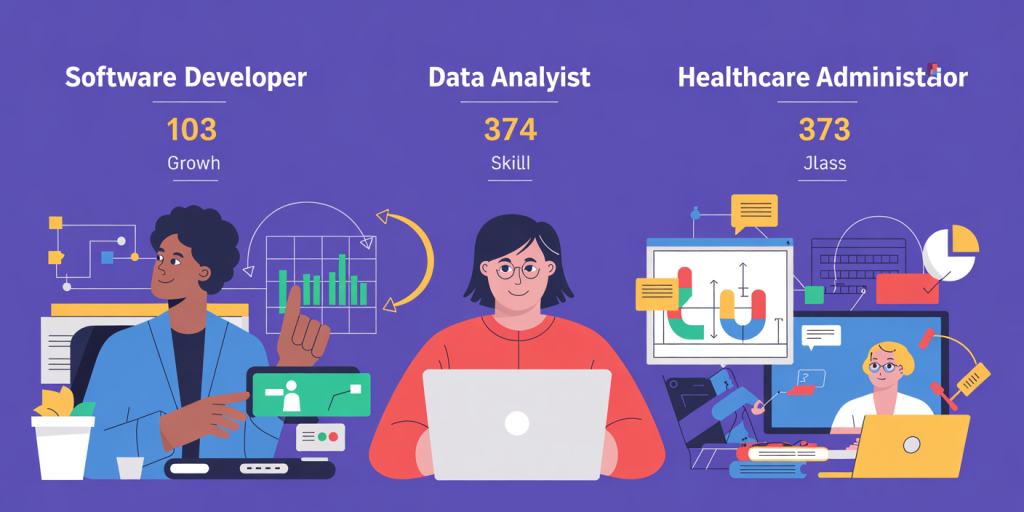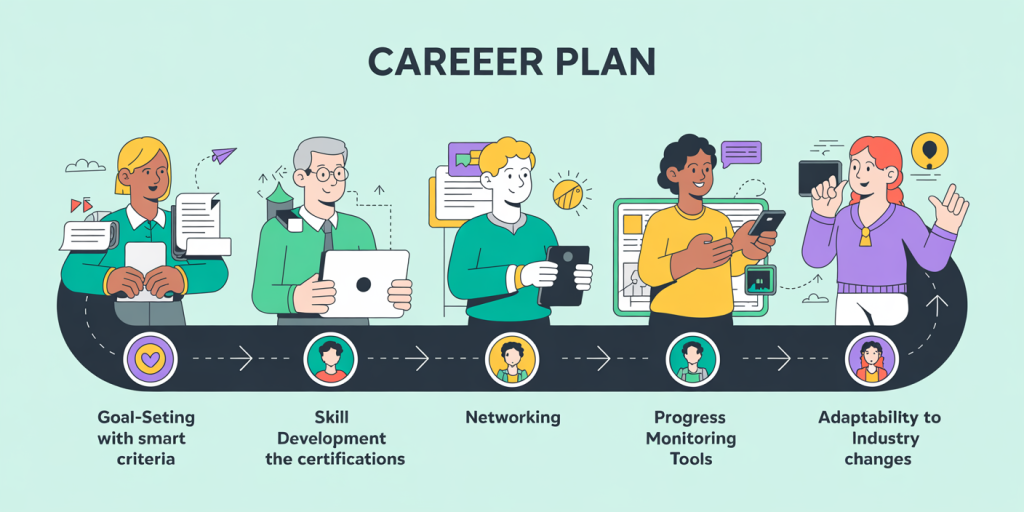How to Build a Career Plan in 5 Steps
In today’s rapidly evolving job market, building a solid career plan has become an essential part of professional growth and success. According to a 2023 LinkedIn Workforce Report, over 70% of professionals believe that proactive career planning enhances their job satisfaction and long-term earning potential. Navigating career decisions without a structured approach can lead to stagnant progress, missed opportunities, or job dissatisfaction. Therefore, understanding how to build a career plan systematically allows individuals to anticipate industry trends, leverage their strengths, and align their ambitions with real-world opportunities.
A well-crafted career plan is not just a static document; it is a dynamic tool that adapts with personal development and external market factors. Whether you are a recent graduate entering the workforce, a mid-career professional seeking advancement, or someone pivoting into a new industry, a structured plan serves as a roadmap guiding your choices. This article provides a comprehensive five-step framework for constructing an actionable career plan, complete with practical examples and comparisons to help you apply these principles successfully.

—
Step 1: Self-Assessment — Understanding Your Strengths and Interests
The foundation of any effective career plan is a deep understanding of one’s own skills, values, and passions. Self-assessment involves introspection and evaluation to identify what motivates you, where your strengths lie, and which environments you thrive in. In a 2022 survey by the Society for Human Resource Management (SHRM), 65% of hiring managers noted that candidates with a clear sense of their strengths tend to perform better and advance faster than those without.

Begin by listing your hard skills (technical abilities, certifications) and soft skills (communication, leadership). Complement this by considering your personal values, such as work-life balance, social impact, or financial security. For instance, Jane, a graphic designer who values creativity and autonomy, might rank freelance opportunities higher than corporate roles that have stricter processes.
One useful tool is the SWOT analysis (Strengths, Weaknesses, Opportunities, Threats) tailored to your career. This allows you to identify internal capabilities and external conditions affecting your growth potential. Consider how your skills match industry demands. For example, a software engineer proficient in AI and machine learning is better positioned for growth in tech sectors compared to specialists in legacy systems.
—
Step 2: Research and Explore Career Options
After understanding your personal profile, the next step is to research viable career options aligned with your assessment results. The U.S. Bureau of Labor Statistics projects that occupations in healthcare and technology will grow by 13% and 15%, respectively, over the next decade — data that should influence career planning decisions.
Start by gathering detailed information about potential roles: job descriptions, required qualifications, salary ranges, and progression paths. Utilize resources such as industry reports, company websites, informational interviews, and professional networking platforms like LinkedIn. For example, Tom, considering a shift from finance to data analytics, conducted informational interviews with data scientists to gain insights into daily responsibilities and necessary credentials.
Creating a comparative table can streamline decision-making:
| Career Option | Average Salary (USD) | Job Growth (2022-2032) | Required Education | Skill Match Level (1-5) |
|---|---|---|---|---|
| Software Developer | $110,000 | 15% | Bachelor’s in CS | 4 |
| Data Analyst | $75,000 | 25% | Bachelor’s + certifications | 5 |
| Financial Analyst | $85,660 | 11% | Bachelor’s degree | 3 |
| Healthcare Administrator | $100,980 | 28% | Bachelor’s + experience | 2 |
This table allows a clear visual comparison, helping prioritize options based on career growth, financial rewards, and personal fit.

—
Step 3: Set Specific, Measurable, Achievable, Relevant, Time-bound (SMART) Goals
Clear goal-setting transforms vague ambitions into defined objectives that drive daily decisions. The SMART framework provides criteria for crafting goals that are actionable and trackable. For example, rather than stating “I want a promotion,” a SMART goal would be “Secure a team lead position in my department within 18 months by completing leadership training and successfully leading two projects.”
Consider Maria, a marketing professional aiming to upskill in digital marketing. Her SMART goal was: “Obtain Google Analytics certification within 6 months and apply skills in three client projects by year-end.” This clarity helped her stay focused and measure progress objectively.
Distinguishing between short-term and long-term goals is important. Short-term goals may include completing educational courses or improving particular skills, while long-term goals could target roles or salary milestones. Tracking progress through tools like Trello, Notion, or even simple spreadsheets can facilitate consistent follow-ups and adaptations.
—
Step 4: Develop an Action Plan and Acquire Necessary Skills
With goals in place, the next phase involves outlining actionable steps and identifying skill gaps. Continuous learning is pivotal in today’s workforce where job requirements evolve rapidly. According to the World Economic Forum’s 2023 Future of Jobs Report, 50% of all employees will need reskilling by 2025.
Start by listing courses, workshops, certifications, or on-the-job experiences necessary to bridge your skill gaps. For example, Alex, transitioning from mechanical engineering to project management, enrolled in a Project Management Professional (PMP) certification and volunteered to lead smaller projects to gain hands-on experience.
Networking is another critical aspect of the action plan. Building relationships with industry professionals can open doors to mentorship, job leads, and insider knowledge. Platforms like LinkedIn provide excellent opportunities to join groups, attend webinars, and connect with thought leaders.
To help visualize the difference between skill acquisition types, consider this comparison:
| Skill Acquisition Method | Time Investment | Cost | Practical Application | Long-Term Value |
|---|---|---|---|---|
| Online Courses | Medium | Low to Medium | High | High |
| Formal Degree Programs | High | High | Medium | Very High |
| Certifications | Medium | Medium | High | High |
| On-the-job Training | Varies | Usually free | Very High | High |
| Networking & Mentorship | Ongoing | Low | High | Very High |
This comparison aids in choosing the most efficient combination of methods based on personal resources and career goals.
—
Step 5: Monitor Progress and Adapt the Plan
Career planning is an iterative process. Regularly reviewing and adjusting your plan ensures alignment with changes in your interests, industry shifts, or new opportunities. A study by Deloitte in 2023 found that 60% of professionals benefit from revisiting their career goals annually to stay competitive and motivated.
Set milestones to evaluate your progress against the SMART goals. Reflect on achievements and obstacles to refine your strategies. For example, if you find the demand for certain certifications increasing or your passion shifting towards a different specialty, updating your action plan is essential.
Moreover, economic or technological changes might prompt reskilling or sector switching. The COVID-19 pandemic dramatically altered labor markets, with remote work and digital collaboration becoming standard. Professionals who adapted their plans quickly retained or enhanced their employability.
Tracking tools like career journals, performance apps, or regular coaching sessions can facilitate self-assessment. Incorporating feedback from mentors or supervisors can also provide external perspectives for growth.
—
Emerging Trends and Future Perspectives in Career Planning
Looking forward, career planning will increasingly rely on digital tools and data-driven insights. Artificial intelligence-powered career coaches and platforms like Coursera’s Career Academy or LinkedIn Learning are becoming essential resources for personalized skill development and job matching.
Furthermore, the concept of career longevity is shifting. Instead of a single linear career path, many professionals will experience “portfolio careers,” combining freelance projects, multiple part-time roles, or continual re-skilling throughout their lives. According to a 2024 McKinsey report, up to 30% of the workforce in advanced economies may engage in multiple career streams simultaneously by 2030.
Environmental, social, and governance (ESG) factors are also influencing career decisions, as younger professionals prioritize employers’ commitments to sustainability and social responsibility. Future career plans might thus incorporate values-based criteria more strongly.
Overall, adaptability, lifelong learning, and proactive planning will remain the cornerstones of career success. Those who embrace these principles will be better poised to navigate uncertainties and fulfill meaningful professional aspirations.
—
Through these five structured steps—self-assessment, research, goal setting, skill development, and adaptive monitoring—you can construct a resilient and actionable career plan. This approach maximizes your potential for growth, satisfaction, and long-term achievement in an ever-changing professional landscape.
